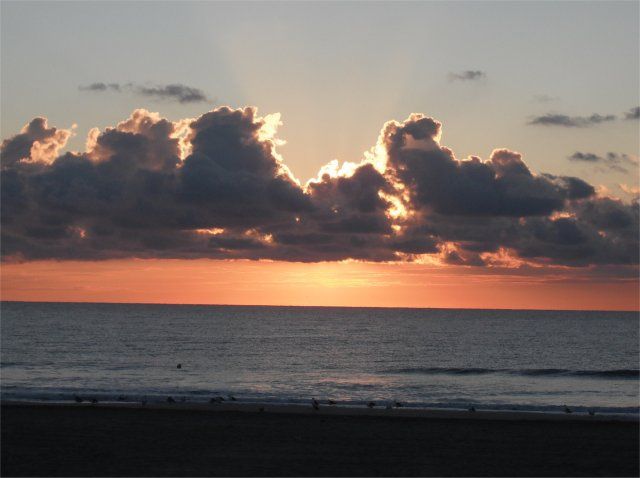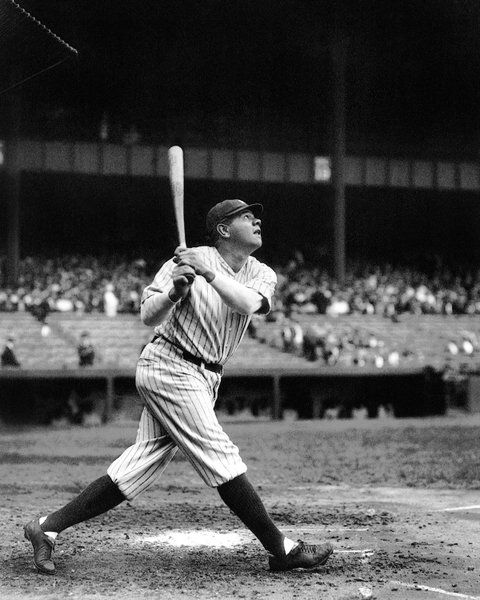Forum Replies Created
-
AuthorPosts
-
The Four Seasons
“Silence is Golden”Miss Pookie, there is this one tooJohn Denver
Falling Out of Lovehttps://www.youtube.com/watch?v=O6QzGja-934
The Beach Boys
“Pet Sounds”anytime for you Pook
This morning's sunrise
brought to you by God
shared by me
Miss Brandy and I reach a spot where it looks as if the fishing will be good. I tuck the boat against a partially submerged tree so we won't drift. Next I produce some cord from the pile of things in the bottom of the boat and proceed to tie the bottle of Bacardi to one end and the bottle of bourbon to the other end, then I drop them over the side into the water and loop the middle of the cord around one of the oar locks. “Nature's cooler”, I say in answer to the puzzled look I get from her. Finding another piece of cord, I do the same thing with the bottles of coke.
The sky is beginning to brighten as the sun begins to rise. “The fishies will be stirrin' soon.” I say, while getting the fishing rods up and ready. I reach into the pail and pull out a wiggler, and begin to bait the hook.
“What are you doing?” Miss Brandy asks in a shakey voice.
“Baiting the hook,” I reply.
“You're going to kill it?!” She asks a little louder.
“No,” I answer, while still holding the unskewered worm, “the fish are going to kill it when it gets eaten…”
“You didn't say we were going to kill them,” are the next words that come from Miss Brandy.
I answer, “We're going fishing, what did you think was going to happen to them?”
“I don't know”, she answers, “but I can't kill anything… it will make me cry to watch it wriggling on the hook.” I can see her eyes beginning to tear up at just the thought of it.
I drop the night crawler back into the pail. Murmuring a few words under my breath, I open the tackle box and inspect the lures. I find some rubber worms in the box and we decide to use those instead of the live bait. “I have a small can of WD-40 we can spray the rubber worms with before dropping the lines into the water. It's a fish oil based lubricant and the fishies love it.”
It begins to come up on noon time, and by now we have the umbrella up in the boat to protect us from the sun. The day is heating up nicely and the fishing has been lively. We catch and release them and chatter away about all sorts of things while also relieving the picnic basket of some of it's contents.
Resting her fishing pole against the side of the boat, Miss Brandy starts to take off her light jacket and that's when I notice it.
“You've got my red shirt!” I exclaim. “When… wait… um. How did you get it?”
“I'm not sure.” Miss Brandy states, “remember when we were drowing our sorrows that night by the campfire?”
“Yes”, I answer, then state, “I thought the shirt fell in the fire or something… the last thing I remember was you doing that little hootchie kootchie dance in front of the fire and… uh oh… what else happened?”
Foreigner
“Head Games”John Denver
“I'd Rather Be A Cowboy” (Lady's Chains) The Babe
The Babe
The institution of slavery was firmly established in the American colonies by the time of the American Revolution. The total of a half million slaves were spread out through all of the colonies, but It was most important in the six southern states from Maryland to Georgia. 40% of the South’s population was made up of slaves, and as Americans moved into Kentucky and the rest of the southwest fully one-sixth of the settlers were slaves. By the end of the war, the New England states provided most of the American ships that were used in the foreign slave trade while most of their customers were in Georgia and the Carolinas.
During this time many Americans found it difficult to reconcile slavery with their interpretation of Christianity and the lofty sentiments that flowed from the Declaration of Independence. A small antislavery movement, led by the Quakers, had some impact in the 1780s and by the late 1780s all of the states except for Georgia had placed some restrictions on their participation in slave trafficking. Still, no serious national political movement against slavery developed, largely due to the overriding concern over achieving national unity. When the Constitutional Convention met, slavery was the one issue that left the least possibility of compromise, the one that would most pit morality against pragmatism. In the end, while many would take comfort in the fact that the word slavery never occurs in the Constitution, critics note that the three-fifths clause* provided slaveholders with extra representatives in Congress, the requirement of the federal government to suppress domestic violence would dedicate national resources to defending against slave revolts, a twenty-year delay in banning the import of slaves allowed the South to fortify its labor needs, and the amendment process made the national abolition of slavery very unlikely in the foreseeable future.
With the outlawing of the African slave trade on January 1, 1808, many Americans felt that the slavery issue was resolved. Any national discussion that might have continued over slavery was drowned out by the years of trade embargoes, maritime competition with Great Britain and France, and, finally, the War of 1812 (when the United States once again kicked Great Britain’s ass
 ). The one exception to this quiet regarding slavery was the New Englanders' association of their frustration with the war with their resentment of the three-fifths clause that seemed to allow the South to dominate national politics.
). The one exception to this quiet regarding slavery was the New Englanders' association of their frustration with the war with their resentment of the three-fifths clause that seemed to allow the South to dominate national politics.In the aftermath of the American Revolution, the northern states (north of the Mason-Dixon Line separating Pennsylvania and Maryland) abolished slavery by 1804. The Mason-Dixon Line runs east through the southern part of New Jersey, so yes… there were slaves in the North. In the 1787 Northwest Ordinance, Congress (still under the Articles of Confederation) barred slavery from the Mid-Western territory north of the Ohio River, but when the U.S. Congress organized the southern territories acquired through the Louisiana Purchase, the ban on slavery was omitted.
* The Three-Fifths Compromise
The Three-Fifths Compromise was a compromise reached between delegates from southern states and those from northern states during the 1787 United States Constitutional Convention. The debate was over if, and if so, how, slaves would be counted when determining a state's total population for constitutional purposes. The issue was important, as this population number would then be used to determine the number of seats that the state would have in the United States House of Representatives for the next ten years, and to determine what percentage of the nation's direct tax burden the state would have to bear. The compromise was proposed by delegates James Wilson and Roger Sherman.The Convention had unanimously accepted the principle that representation in the House of Representatives would be in proportion to the relative state populations. However, since slaves could not vote, non-slaves in slave states would thus have the benefit of increased representation in the House and the Electoral College. Delegates opposed to slavery proposed that only free inhabitants of each state be counted for apportionment purposes, while delegates supportive of slavery, on the other hand, opposed the proposal, wanting slaves to count in their actual numbers. A compromise which was finally agreed upon—of counting “all other persons” as only three-fifths of their actual numbers—reduced the representation of the slave states relative to the original proposals, but improved it over the Northern position. An inducement for slave states to accept the Compromise was its tie to taxation in the same ratio, so that the burden of taxation on the slave states was also reduced.
The Three-Fifths Compromise is found in Article 1, Section 2, Paragraph 3 of the United States Constitution which reads:
Representatives and direct Taxes shall be apportioned among the several States which may be included within this Union, according to their respective Numbers, which shall be determined by adding to the whole Number of free Persons, including those bound to Service for a Term of Years, and excluding Indians not taxed, three fifths of all other Persons.
The Clancy Brothers and Tommy Makem
“Will Ye Go Lassie Go”Flags of the ConfederacyThe Confederate States of America adopted three different national flag patterns between 1861 and 1865. The Provisional Confederate Congress adopted the First National pattern, also referred to as the “Stars and Bars”, on March 4, 1861. This pattern flag flew over the Capitol at Montgomery, Alabama, where the Provisional Congress met prior to the bombardment of Fort Sumter in April 1861.

The Second National pattern, also referred to as the “Stainless Banner”, was adopted May 1, 1863 and incorporated the Army of Northern Virginia’s battle flag design in the canton on a white field. The first official use of the Second National pattern flag was on Stonewall Jackson's casket when his body lay in state in Richmond, May 10, 1863.

The Third National pattern, adopted March 4, 1865, shortened the white field and added a vertical red bar to the end of the Second National pattern flag. Very few, if any, of the Third National pattern flags saw service during the war, since General Lee's Army of Northern Virginia surrendered just a few weeks later at Appomattox.

In addition to the national flags of the Confederacy, there were many battle flag patterns used by the Confederate armies.

The Army of Northern Virginia pattern battle flag, first issued to units beginning in November 1861, was designed to be a distinctive flag for use on the battlefield. It underwent numerous revisions in design and materials throughout the war. Although this particular flag is the most common flag pattern associated with the Confederate States of America, the Confederate Congress never officially adopted this flag, except as the canton of the Second and Third National patterns.
taken from: http://www.moc.org/collections-archives/flags-confederacy
In my opinion, the two main reasons why the battle flag is offensive to many:
1. It represents the south's desire to continue the “peculiar institution” which was a euphemism for slavery. When you prune all the causes of the American Civil War to it's roots, slavery is what remains. Some will argue it was for state's rights, but that right they speak of was linked to slavery.
2. In almost every picture or depiction of white supremacy groups, such as the Klu Klux Klan, that battle flag is usually present.
Anita Baker
“Lately”Hey Kids… time for another lesson from
Covems'
Origami Class
check back soon
The Lumineers
“Ho Hey” -
AuthorPosts


 ). The one exception to this quiet regarding slavery was the New Englanders' association of their frustration with the war with their resentment of the three-fifths clause that seemed to allow the South to dominate national politics.
). The one exception to this quiet regarding slavery was the New Englanders' association of their frustration with the war with their resentment of the three-fifths clause that seemed to allow the South to dominate national politics.



